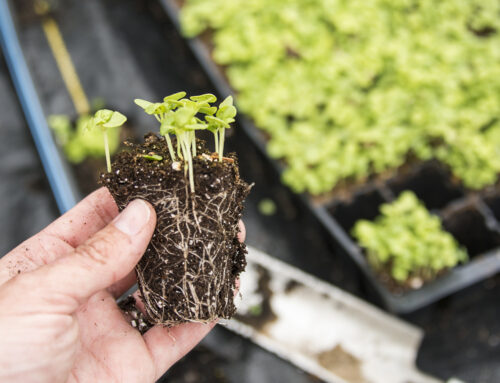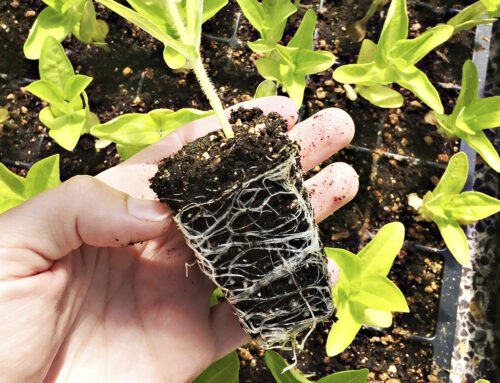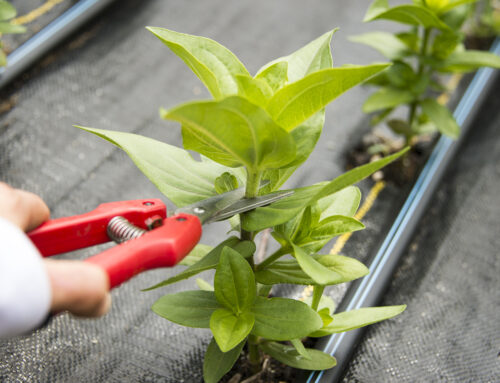I’m going to level with you, even though you aced Seed Sowing, and your seedlings happily growing and green, they’re not exactly ready to go in the ground just yet. Young plants often need to be thinned, transplanted and grown on before they’re ready for the garden. In addition, they may require repotting. And hardening off is a MUST.

Thinning
Typically, I sow seed more than once seed per pot (or cell) to ensure good germination. Most seeds doesn’t have 100% germination rate. So what happens when you have two, three—or heaven forbid, more—seeds that germinate per pot?!

Thinning is super-duper important. You need to remove the extra seedlings, otherwise their growth will be stunted. Discarding the extra seedlings allows more room for the single plant to root, grow and develop in a healthy way.
How do you thin seedlings? Again, way simple. Using clean, sharp snips or scissors, cut out the weakest, rangiest green growth at the surface of the soil, leaving a single seedling. Boom! That’s it!

Repotting
Transplanting tender annuals, such as tomatoes and scented geraniums, into larger pots strengthens your seedlings. Although optional, I prefer repotting in most cases because it does two things. Bigger pots with more soil allows the root system to get larger and more robust. And the seedling can be planted deeper for better anchoring—extraordinarily helpful for top-heavy producers like tomatoes. You’ll know it’s time to thin and repot when your seeding has grown their second set of true leaves. This means 6 total leaves if you’re new to gardening.
Water, thin, then gently remove your seedling from the tray. Place the seedling in the center of a larger (I use 4” round) pot filled half-way with moist soil. Add more soil and firm up the seedling in its new pot. I give my newly repotted seedling a diluted dose of fish emulsion with seaweed to give it a little boost. Water as needed and watch it grow!

Repotting Tip: When repotting I like to remove the lower two seedling leaves (these often look different than the rest of the leaves) and bury that portion of the stem below the soil line. The new soil along with open “wounds” where the previous leaves were located will encourage new root growth, allowing the seedling to develop into a larger, healthier, more vigorous and stable plant that will preform better in the garden.
Hardening Off
Hardening off is essential for a thriving, productive garden. This simple process takes 7-10 days of gradually exposing your seedlings to cooler temperatures and weather conditions.
If you were to directly plant seedlings started in your home into the garden, you would probably be wondering why they aren’t growing very fast over the first couple weeks. Seedlings need to acclimate to these conditions. Otherwise expect shock or seedling deaths if the difference in temperatures is too great.
Properly hardened off seedlings grow quickly and eagerly in the garden. Because they slowly were exposed to bright sun and cool temperatures, they are not stunted.
Start 10 days before you plant to plant out in the garden. Begin by setting your seedlings out in a cold frame—or by a window in the garage—for a couple hours each day, gradually increasing the time spent in this sheltered location. Then over the next week, move your seedling to a progressively cooler and less sheltered locations. This will prepare your plants to be transplanted in the garden.

Hardening Off Simplified
Think of it this way, over the first three days your seedlings are placed by the garage window for 4, 8 and 12 hours. On days four and five, move them outside—but beside—the garage wall for sheltering from winds, for 5 and 10 hours each day respectively. Day six, the seedlings are positioned outside, away from the garage for half the day. And over days seven through ten, they are steadily exposed to the outside elements for longer and longer each day until they are fully ready to live outside in the garden.





[…] Thinning. Watering (of course). Pinching-back. And Harvesting. Getting tired just thinking about it. […]